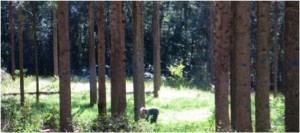Australia’s “agroforestry” movement is gaining momentum, as farmers revegetate their land with harvestable timber, while reaping all the natural benefits trees offer livestock systems. Source: ABC Rural
Described as “the wise use of trees and shrubs”, hundreds of producers are signing up to Government-funded Master Tree Grower courses, that teach them how to diversify into forestry without affecting their existing farm enterprise.
Kalangadoo sheep and cattle farmer, Nick Hunt, has spent decades trying to reverse the damage done when his great-grandfather cleared his South Australian property for precious grazing land.
Today about 15% of the farm is vegetated and Mr Hunt said there was no sacrifice to his livestock business.
“I’m sure I can carry a similar number of cattle because of the shelter that not only the stock get, but also the pasture,” he said.
“Keeping the prevailing winds up off ground level is helping pasture growth.
“It creates a nicer place to be, that’s the main thing for me.”
Kalangadoo is in the Green Triangle region of South Australia, where some of the nation’s biggest forestry companies harvest a selection of hard and soft woods. But Mr Hunt said there was still room in the market for his small offering of pine and blue gum.
In 2009 he harvested 90% of a successful blue gum plantation, pocketing a “tidy financial bonus”.
The best 10% of trees remain standing, their value increasing as years pass by and new generations of sheep and cattle benefit from their shelter. Eventually they will be harvested as high quality timber.
“At the moment probably veneer for China is the most appealing,” he said. “We’ll find out in due course.”
Mr Hunt said many of his peers had lost faith in blue gum plantations, due to the sharp drop in value during the global financial recession.
“That industry is recovering fairly rapidly, we hear, now,” he said. “Hopefully the whole tree-planting ethic will be revived and people appreciate that we need, in many cases, more trees in our landscape.”
Port Macdonell’s Peter Feast has shaped his business around the promise of more farmers seeing the benefits of tree plantations.
Once a sheep and beef farmer, he now runs a native nursery and does contract direct-seeding for farmers in the region.
“Like most farmers I started planting trees around the house, to protect the house,” he said.
“I grew a fruit orchard, a vegie garden, all that sort of thing and then we progressed out into the paddocks with windbreaks.”
But trees soon became more about making money than creating a beautiful landscape.
“About 20 years ago I could see the benefits of having some forestry on the farm, for economic diversity,” he said. “We went through the 1990 sheep crash, where they were shooting sheep all around Australia, and the live (export) boats stopped running.
“At that stage we increased our revegetation and nursery business and thought about some farm forestry as well, and I’m glad we did.
“You go back and do the calculations on how many sheep or lambs we would have used off that paddock, the forestry side of it was ahead of the grazing side of it.”
Mr Feast does concede there are difficulties competing with large corporations but stressed they made his forestry enterprise possible, by providing the infrastructure needed.
“Where it will be a little bit more difficult is some of the speciality timbers we have,” he said.
“There’s no actual log market for those so that’s where we probably have to mill them up ourselves and then you can value-add and sell some finished product.”






